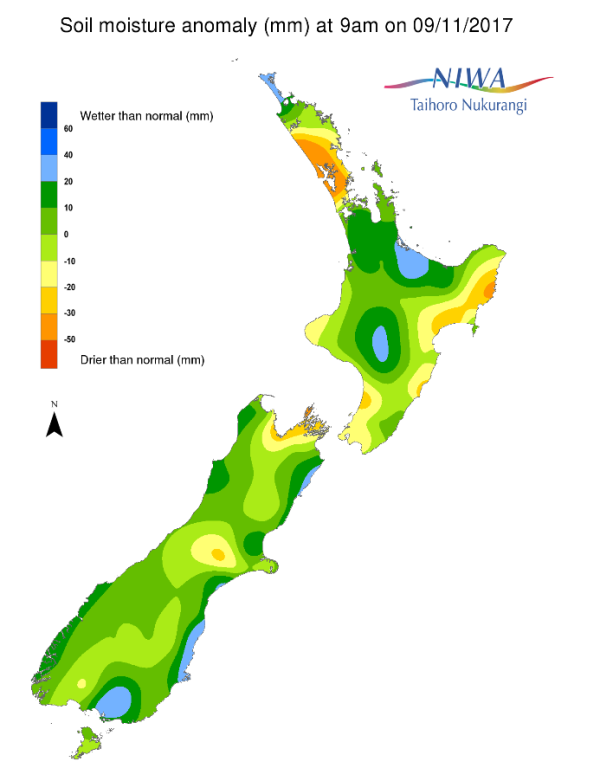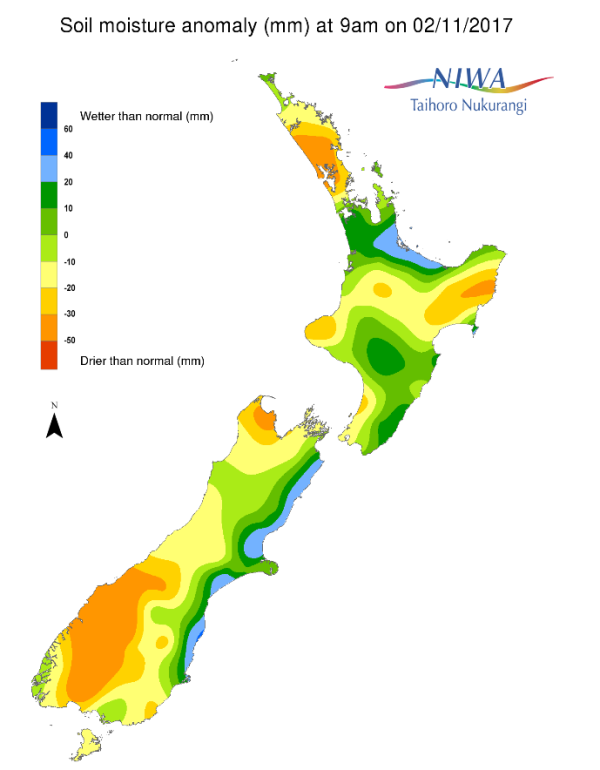A weekly update describing soil moisture across the country to help assess whether severely to extremely dry conditions are occurring or imminent. Regions experiencing these soil moisture deficits are deemed “hotspots”. Persistent hotspot regions have the potential to develop into drought.
Facts: Soil Moisture
Across the North Island, soil moisture levels have generally not changed significantly during the past week. However, some increases were observed near Cape Reinga as well as central Waikato to northern Manawatu-Whanganui. Meanwhile, minor soil moisture decreases occurred along coastal Hawke’s Bay and in the Wellington region. The driest soils across the North Island compared to normal for this time of the year are found in southern Northland, northern Auckland, and coastal Gisborne, while the wettest soils for this time of the year are located around Cape Reinga, western Bay of Plenty, and in the Ruapehu District.
A small hotspot remains located along the central Gisborne coast.
Across the South Island, soil moisture levels have generally increased substantially during the past week, while decreasing slightly along the eastern coast. The increases were most prevalent in Tasman, West Coast, interior Otago, and Southland, and occurred due to the heavy rain that moved across the South Island earlier this week. The driest soils across the South Island compared to normal for this time of the year are now found in Nelson and northern Marlborough, while the wettest soils for this time of the year are found near Kaikoura and north of Dunedin.
The hotspot previously located in Central Otago and Waitaki has dissipated due to the heavy rainfall earlier this week.
Outlook and Soil Moisture
A potent subtropical low is expected to pass near the upper North Island on Friday night and Saturday (11th November), and this could provide substantial rainfall to Northland, Auckland, and Gisborne. While parts of Northland and Auckland may receive 25-50 mm, amounts could exceed 80 mm across Gisborne by Sunday morning. However, the western and southern North Island will only be grazed by this low, and rainfall amounts in these areas will be less than 15 mm. Only minimal additional rainfall is expected next week as high pressure will move overhead. While isolated showers may provide a couple of millimetres to some locations, other spots will remain completely dry.
Moderate rainfall in the upper North Island on Saturday should allow soil moisture levels to increase at least slightly in much of Northland and Auckland during the next week. In Gisborne, the expected heavy rain should alleviate the small hotspot and significantly increase soil moisture levels. However, generally meagre rainfall in the western and southern North Island will likely lead to decreasing soil moisture levels, although hotspot formation is not expected.
For the South Island, high pressure will be the dominant feature over the next week, and this will lead to minimal rainfall for nearly all locations. A few spotty showers will occur in eastern and southern areas through this weekend, but rainfall totals will likely remain below 10-15 mm. By Monday, high pressure moving directly overhead will lead to several days of almost complete dryness in the South Island.
Due to minimal rainfall, soil moisture levels are likely to decrease almost everywhere in the South Island during the next week, which may allow a new hotspot to form in interior Selwyn District. While soil moisture levels will likely decrease quickly across interior Otago and Southland, a re-emergence of a hotspot there is unlikely during the next week.
Background:
Hotspot Watch: a weekly advisory service for New Zealand media. It provides soil moisture and precipitation measurements around the country to help assess whether extremely dry conditions are imminent.
Soil moisture deficit: the amount of water needed to bring the soil moisture content back to field capacity, which is the maximum amount of water the soil can hold.
Soil moisture anomaly: the difference between the historical normal soil moisture deficit (or surplus) for a given time of year and actual soil moisture deficits.
Definitions: “Extremely” and “severely” dry soils are based on a combination of the current soil moisture status and the difference from normal soil moisture (see soil moisture maps)


